Black + White = Black - Department of Psychology
advertisement
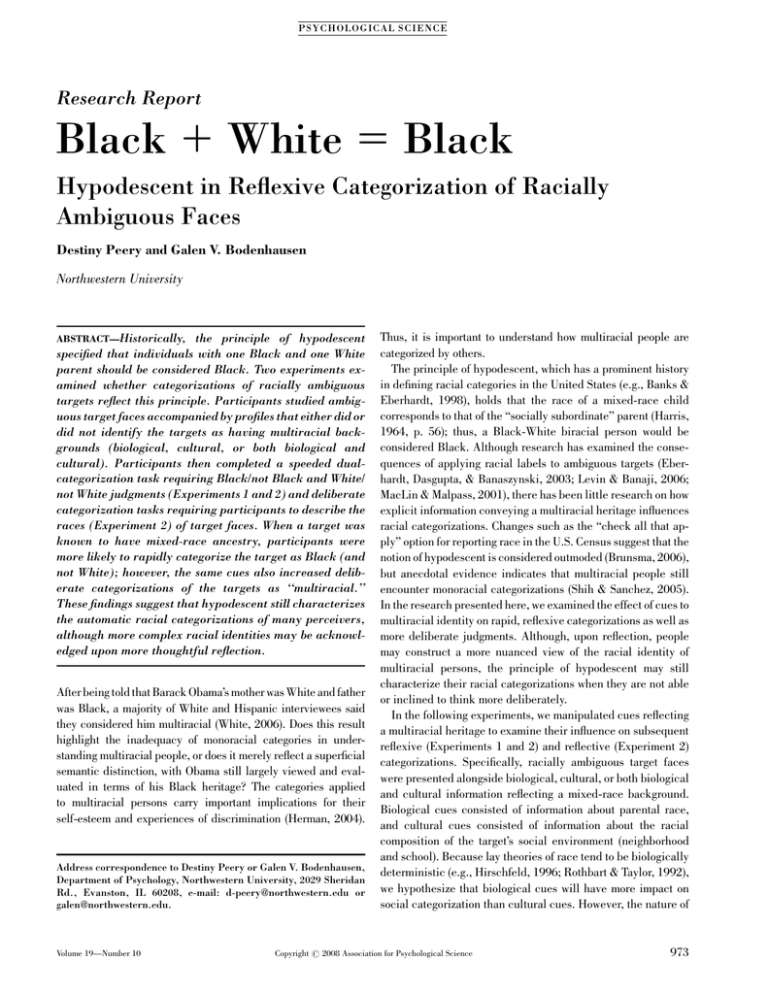
PS YC HOLOGICA L SC IENCE Research Report Black 1 White 5 Black Hypodescent in Reflexive Categorization of Racially Ambiguous Faces Destiny Peery and Galen V. Bodenhausen Northwestern University ABSTRACT—Historically, the principle of hypodescent specified that individuals with one Black and one White parent should be considered Black. Two experiments examined whether categorizations of racially ambiguous targets reflect this principle. Participants studied ambiguous target faces accompanied by profiles that either did or did not identify the targets as having multiracial backgrounds (biological, cultural, or both biological and cultural). Participants then completed a speeded dualcategorization task requiring Black/not Black and White/ not White judgments (Experiments 1 and 2) and deliberate categorization tasks requiring participants to describe the races (Experiment 2) of target faces. When a target was known to have mixed-race ancestry, participants were more likely to rapidly categorize the target as Black (and not White); however, the same cues also increased deliberate categorizations of the targets as ‘‘multiracial.’’ These findings suggest that hypodescent still characterizes the automatic racial categorizations of many perceivers, although more complex racial identities may be acknowledged upon more thoughtful reflection. After being told that Barack Obama’s mother was White and father was Black, a majority of White and Hispanic interviewees said they considered him multiracial (White, 2006). Does this result highlight the inadequacy of monoracial categories in understanding multiracial people, or does it merely reflect a superficial semantic distinction, with Obama still largely viewed and evaluated in terms of his Black heritage? The categories applied to multiracial persons carry important implications for their self-esteem and experiences of discrimination (Herman, 2004). Address correspondence to Destiny Peery or Galen V. Bodenhausen, Department of Psychology, Northwestern University, 2029 Sheridan Rd., Evanston, IL 60208, e-mail: d-peery@northwestern.edu or galen@northwestern.edu. Volume 19—Number 10 Thus, it is important to understand how multiracial people are categorized by others. The principle of hypodescent, which has a prominent history in defining racial categories in the United States (e.g., Banks & Eberhardt, 1998), holds that the race of a mixed-race child corresponds to that of the ‘‘socially subordinate’’ parent (Harris, 1964, p. 56); thus, a Black-White biracial person would be considered Black. Although research has examined the consequences of applying racial labels to ambiguous targets (Eberhardt, Dasgupta, & Banaszynski, 2003; Levin & Banaji, 2006; MacLin & Malpass, 2001), there has been little research on how explicit information conveying a multiracial heritage influences racial categorizations. Changes such as the ‘‘check all that apply’’ option for reporting race in the U.S. Census suggest that the notion of hypodescent is considered outmoded (Brunsma, 2006), but anecdotal evidence indicates that multiracial people still encounter monoracial categorizations (Shih & Sanchez, 2005). In the research presented here, we examined the effect of cues to multiracial identity on rapid, reflexive categorizations as well as more deliberate judgments. Although, upon reflection, people may construct a more nuanced view of the racial identity of multiracial persons, the principle of hypodescent may still characterize their racial categorizations when they are not able or inclined to think more deliberately. In the following experiments, we manipulated cues reflecting a multiracial heritage to examine their influence on subsequent reflexive (Experiments 1 and 2) and reflective (Experiment 2) categorizations. Specifically, racially ambiguous target faces were presented alongside biological, cultural, or both biological and cultural information reflecting a mixed-race background. Biological cues consisted of information about parental race, and cultural cues consisted of information about the racial composition of the target’s social environment (neighborhood and school). Because lay theories of race tend to be biologically deterministic (e.g., Hirschfeld, 1996; Rothbart & Taylor, 1992), we hypothesize that biological cues will have more impact on social categorization than cultural cues. However, the nature of Copyright r 2008 Association for Psychological Science 973 Hypodescent in Racial Categorization the cues’ effect may depend on the type of judgment. For rapid, reflexive judgments, salient associations should drive responses. When a target has one Black parent and one White parent, the minority parent is likely to be more distinctive and salient, and if rapid categorizations are based on this salient information, then targets may be categorized as monoracially Black, in effect following the rule of hypodescent. However, when judgments are made with greater deliberation, explicit biological information should enhance the application of multiracial rather than monoracial categories, as in the Obama survey (White, 2006). We expected that cues concerning the racial composition of the target’s cultural environment, if they had any effect at all, would be less potent than the biological cues. EXPERIMENT 1 In this experiment, we examined rapid categorizations of racially ambiguous faces. Using a novel dual-categorization task, participants were asked to make both Black/not Black and White/not White judgments about each face as quickly and accurately as possible. Method Participants Fifty-nine non-Black undergraduates (35 White, 10 Asian, 5 Hispanic, 9 other; 32 female, 27 male) completed the experimental tasks in a university laboratory in exchange for course credit. Stimuli The racially ambiguous faces used in the present research represented a 50%:50% morphing of Black and White source faces taken from Minear and Park (2004) and were pretested to confirm their racial ambiguity. Black and White filler faces were obtained from the same database. All faces were matched in age (18–29 years) and had neutral expressions. Participants saw each face paired with a descriptive profile. In addition to the target’s face, the profiles contained basic demographic information and, depending on condition, information about the biological racial background of the target, conveyed by pictures of the target’s parents (one Black and one White parent for racially ambiguous targets; same-race parents for Black and White targets); information about the cultural racial background of the target, conveyed by information about the racial diversity of the target’s social environment (racially mixed for ambiguous targets; predominantly same race for Black and White targets); or information about both the biological and cultural racial backgrounds of the target. The eight critical target profiles featuring racially ambiguous targets reflected two instances (one male, one female) of each combination defined by a 2 (absence or presence of biological race information) 2 (absence or presence of cultural race information) withinsubjects design. The randomly ordered presentation of profiles 974 also included four Black and four White filler profiles, which also varied in the presence or absence of biological and cultural information. Measures A speeded dual-categorization task served as the dependent measure. This task required participants to make fast and accurate judgments regarding whether target faces reflected someone who was ‘‘Black’’ or ‘‘not Black,’’ and on a counterbalanced block of trials, whether the same faces reflected someone who was ‘‘White’’ or ‘‘not White.’’ Each of these judgments was made twice for 28 target faces (8 Black, 8 White, 12 racially ambiguous). Thus, it was possible to determine four categorization patterns by collapsing across the judgments made by participants: Black (i.e., Black/not White), White (i.e., White/not Black), both Black and White, or neither Black nor White. Within each block of trials, the faces were presented in a random order and remained on the screen until a response was made. Procedure Participants were told they would participate in a study concerning how people form impressions from Internet profiles. They were asked to study the profiles in preparation for a memory test. They viewed each of 16 profiles for 25 s and then answered multiple-choice questions about the profile information. After this initial test phase, participants viewed each profile again for 15 s and answered a different set of questions. The memory tests were included to ensure that participants attended closely to the presented information. After the profile-learning phase, participants were unexpectedly asked to complete the dual-categorization task described in the Measures section. They made Black/not Black and White/not White judgments about the 16 studied target faces, as well as 12 unstudied faces (4 Black, 4 White, and 4 ambiguous faces). Finally, they reported basic demographic information. Results and Discussion The categorization patterns for the racially ambiguous faces were based on two White/not White judgments and two Black/ not Black judgments for each target. Participants were considered to have categorized an ambiguous face as ‘‘Black’’ when they responded ‘‘Black’’ at least once and ‘‘not White’’ both times. The converse was true for ‘‘White’’ categorizations. ‘‘Neither White nor Black’’ applied when respondents chose ‘‘not Black’’ and ‘‘not White’’ both times, whereas ‘‘both Black and White’’ applied if they chose ‘‘Black’’ and ‘‘White’’ at least one time each.1 1 Analyses in which categorization patterns were defined more strictly, such that the same response had to be chosen on both trials of the relevant type, produced comparably significant results. Volume 19—Number 10 Destiny Peery and Galen V. Bodenhausen TABLE 1 Mean Frequency of Racial Categorizations in Experiment 1 as a Function of the Type of Information Presented About the Target’s Background Racial categorization Condition No information Biological information only Cultural information only Both biological and cultural information Black White Both Neither 33.9 (5.1) 37.3 (5.4) 39.9 (5.3) 51.7 (5.7) 17.8 (4.3) 15.2 (3.9) 27.1 (4.4) 9.4 (3.1) 23.7 (4.3) 23.7 (4.4) 18.6 (4.5) 15.3 (3.7) 24.6 (4.8) 23.7 (4.6) 14.4 (3.7) 23.7 (4.8) Note. Mean frequencies are expressed as a percentage. Standard errors are given in parentheses. Results of the speeded categorization task are presented in Table 1. The columns in the table represent the four possible categorization patterns. The rows represent the four experimental variations in the type of information presented about targets. The mean percentage of each categorization pattern in each experimental condition is presented. If explicit information about a biracial background discourages the application of a monoracial category, we would expect to see an increase in the extent to which such faces are categorized as ‘‘both Black and White,’’ ‘‘neither Black nor White,’’ or both. The data clearly show no such pattern, as the use of these categories remained the same or declined with the presentation of multiracial background information of any kind. Instead, results were consistent with the notion of hypodescent: Ambiguous targets were more likely to be categorized as ‘‘Black’’ if they were known to have one Black parent or live in a racially mixed neighborhood. Contrary to expectations, the biological and cultural cues had comparable effects in encouraging ‘‘Black’’ categorizations. A repeated measures analysis of variance (ANOVA) on the rate of ‘‘Black’’ categorizations as a function of the availability of biological and cultural information confirmed reliable main effects for biological information, F(1, 58) 5 5.84, p < .02, Zp 2 ¼ :09 (Ms 5 44.5 vs. 36.9), and for cultural information, F(1, 58) 5 6.01, p < .02, Zp 2 ¼ :09 (Ms 5 45.8 vs. 35.6). The interaction was not significant, p > .11, Zp 2 ¼ :04. We hypothesized that, although the explicit cues to multiracial identity imply having both Black and White heritages (either biological or cultural in nature), the Black/minority aspect would be more distinctive and salient. As a result of this salience, rapid categorizations were expected to be biased toward the Black category when multiracial cues were present. Analyses of response times in the categorization task are consistent with this account. In these analyses, responses faster than 300 ms or slower than 3,000 ms were replaced with 300 and 3,000 ms, respectively (3.9% of trials). Response times from the first categorization of each racially ambiguous face as Black/not Black and White/not White were submitted to a within-subjects ANOVA; results revealed a main effect of biological cues, such that categorizations were faster when biological cues were present (M 5 1,102 ms) than when they were absent (M 5 1,181 ms), F(1, 58) 5 4.88, p < .04, Zp 2 ¼ :08. However, cultural Volume 19—Number 10 cues exerted no effect on response times (F < 1). To further explore the effect of biological cues on response times, we examined the two kinds of responses composing a ‘‘Black’’ categorization: ‘‘Black’’ and ‘‘not White.’’ As expected, participants were faster to select ‘‘Black’’ when biological cues were present (M 5 1,004 ms) than when they were absent (M 5 1,226 ms), F(1, 35) 5 4.65, p < .04, Zp 2 ¼ :12. In contrast, biological cues had no impact whatsoever on the speed with which ‘‘not White’’ categorizations were made (F < 1). These results are consistent with the hypothesis that minority identities are more accessible and defining for multiracial targets, at least under conditions of limited deliberation. EXPERIMENT 2 Experiment 1 demonstrated that when given information about the biracial background of a target, reflexive Black categorizations increase. However, we hypothesized that reflective, deliberated judgments would show the opposite pattern: that is, cues suggesting a multiracial identity should increase the extent to which a multiracial category is applied to a target. In Experiment 2, we included both rapid and deliberate categorization tasks. We predicted that whereas explicit cues to multiracial heritage would ironically increase the rate of ‘‘Black’’ categorizations in the reflexive judgment task (replicating Experiment 1), these same cues would increase the rate of ‘‘multiracial’’ categorizations in the deliberate judgment task. Method Participants Forty-seven undergraduates (33 White, 8 Asian, 2 Hispanic, 4 other; 31 females, 16 males) completed the experimental tasks in a university lab in exchange for course credit. Stimuli The same face and profile stimuli from Experiment 1 were used. Measures Procedures were the same as in Experiment 1, except that participants also completed two deliberate categorization tasks 975 Hypodescent in Racial Categorization in which they were asked to describe the race of each of the 16 faces originally presented in the profile-learning phase. In the first of these tasks, participants typed their own racial descriptions of the targets, and in the second measure, participants selected ‘‘Black,’’ ‘‘White,’’ ‘‘multiracial,’’ or ‘‘none of the above.’’ The free responses were coded according to the four categories used in the forced-choice task. In each task, the 16 faces were presented in a random order. Procedure The procedure for Experiment 2 was identical to that of Experiment 1 except that the deliberate categorization tasks were inserted between the speeded racial categorization task and the demographic measures. The free-response version was always completed first, followed by the forced-choice version. Results and Discussion The rapid categorization judgments were analyzed in the same way as in Experiment 1. Replicating earlier results, a repeated measures ANOVA on the rate of ‘‘Black’’ categorizations as a function of the availability of biological and cultural information confirmed a main effect of biological information, F(1, 46) 5 10.84, p < .003, Zp 2 ¼ :19 (see Table 2 for means). However, this time, the effect of cultural information was not reliable and did not interact with biological information, Fs < 1. Unlike the rapid categorization task, in which ‘‘Black’’ categorizations were the most common response, the deliberate task reflected a strong tendency toward ‘‘multiracial’’ categorizations (74.1% of free-response categorizations, 83.5% of forced-choice categorizations). We analyzed the frequency of ‘‘multiracial’’ categorizations in the forced-choice task in a repeated measures ANOVA, as a function of the presence or absence of both biological and cultural information. This analysis revealed a significant main effect of biological information, F(1, 46) 5 6.18, p < .02, Zp 2 ¼ :12. Specifically, participants were more likely to select the ‘‘multiracial’’ category when biological cues were present than when they were absent (see Table 2 for means). The main effect of cultural cues and the interaction of biological and cultural cues were not significant (ps > .10). Taken together, these results show that participants are more likely to rapidly categorize ambiguous targets as Black and deliberately categorize the same targets as multiracial when biological information documenting mixed-race ancestry is present. GENERAL DISCUSSION The results of both experiments show that when a racially ambiguous target is described as having both Black and White ancestry, it significantly increases the likelihood that the target will be reflexively categorized as Black (and not White), compared to when nothing is explicitly known about the target’s racial background. These results suggest that it is the non-White part of an explicitly biracial target’s identity that is more salient and defining, in accordance with hypodescent. At the same time, establishing a mixed racial ancestry significantly increases the likelihood that targets will be categorized as multiracial when judgments involve more thoughtful deliberation. Given that lay perceivers typically construe race in a biologically deterministic manner, we expected that biological cues would exert stronger effects on categorization judgments than would cultural cues. Although the first experiment suggested that information indicating that a target comes from a racially mixed cultural environment could have the same effect on reflexive categorizations as information conveying a mixed genealogical background, the second experiment revealed no influence of cultural information on either reflexive or reflective categorizations. Thus, it does appear that biological cues exert more consistent influence on racial categorizations than do cultural cues, and future research will need to explore the conditions under which cultural information does modulate the categorization of individuals with complex racial identities. The categories that people apply to others matter (Macrae & Bodenhausen, 2000), and their rapid, reflexive responses can determine how social exchanges unfold (Hugenberg & Bodenhausen, 2004). The results presented here suggest that information explicitly conveying a multiracial heritage may primarily serve to make one aspect of a mixed-race person’s TABLE 2 Mean Frequency of Racial Categorizations in Experiment 2 as a Function of the Presence or Absence of Biological Information Racial categorization Condition Rapid categorization Biological information absent Biological information present Deliberate categorization Biological information absent Biological information present Black White Both Neither 31.9 (4.8) 43.6 (5.6) 29.8 (4.7) 19.7 (4.3) 22.9 (4.4) 20.7 (4.5) 15.4 (3.8) 16.0 (4.3) 4.3 (1.6) 6.9 (2.4) 16.0 (3.4) 5.3 (2.3) 79.2 (4.0) 87.8 (3.4) 0.5 (0.5) 0.0 (0.0) Note. Mean frequency is expressed as a percentage. Standard errors are given in parentheses. 976 Volume 19—Number 10 Destiny Peery and Galen V. Bodenhausen identity particularly salient, namely, the ‘‘socially subordinate’’ aspect, and this may have important implications for stereotype activation and ensuing experiences of prejudice and discrimination. It may be that only when perceivers are both motivated and able to reflect upon others in a deliberate manner are they able to escape simplistic, monoracial categorizations of racially complex social targets. Acknowledgments—We thank Jennifer Richeson for her comments on an earlier version of this manuscript. REFERENCES Banks, R.R., & Eberhardt, J.L. (1998). Social psychological processes and the legal bases of racial categorization. In J.L. Eberhardt & S.T. Fiske (Eds.), Confronting racism: The problem and the response (pp. 54–75). Thousand Oaks, CA: Sage. Brunsma, D.L. (2006). Public categories, private identities: Exploring regional differences in the biracial experience. Social Science Research, 35, 555–576. Eberhardt, J.L., Dasgupta, N., & Banaszynski, T.L. (2003). Believing is seeing: The effects of racial labels and implicit beliefs on face perception. Personality and Social Psychology Bulletin, 29, 360–370. Harris, M. (1964). Patterns of race in the Americas. New York: Doubleday. Herman, M. (2004). Forced to choose: Some determinants of racial identification in multiracial adolescents. Child Development, 75, 730–748. Volume 19—Number 10 Hirschfeld, L.A. (1996). Race in the making: Cognition, culture, and the child’s construction of human kinds. Cambridge, MA: MIT Press. Hugenberg, K., & Bodenhausen, G.V. (2004). Ambiguity in social categorization: The role of prejudice and facial affect in racial categorization. Psychological Science, 15, 342–345. Levin, D.T., & Banaji, M.R. (2006). Distortions in the perceived lightness of faces: The role of race categories. Journal of Experimental Psychology: General, 135, 501–512. MacLin, O.H., & Malpass, R.S. (2001). Racial categorization of faces: The ambiguous race face effect. Psychology, Public Policy, and Law, 7, 98–118. Macrae, C.N., & Bodenhausen, G.V. (2000). Social cognition: Thinking categorically about others. Annual Review of Psychology, 51, 93–120. Minear, M., & Park, D.C. (2004). A lifespan database of adult facial stimuli. Behavior Research Methods, Instruments, & Computers, 36, 630–633. Rothbart, M., & Taylor, M. (1992). Category labels and social reality: Do we view social categories as natural kinds? In G. Semin & K. Fiedler (Eds.), Language, interaction, and social cognition (pp. 11–36). London: Sage. Shih, M., & Sanchez, D.T. (2005). Perspectives and research on the positive and negative implications of having multiple racial identities. Psychological Bulletin, 131, 569–591. White, J.K. (2006). Barack Obama and the politics of race. Retrieved June 28, 2007, from http://www.drpsychobabel.com/?page_id=30 (RECEIVED 10/27/07; REVISION ACCEPTED 4/27/08) 977
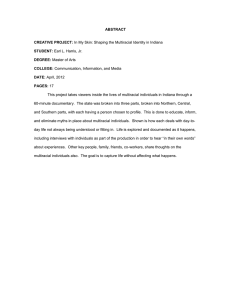
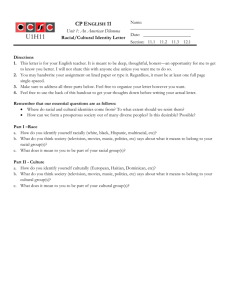
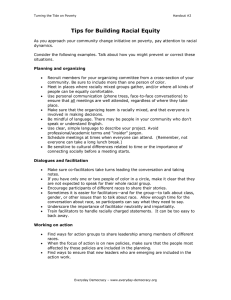

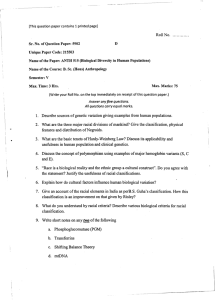
![[insert organizational header]](http://s3.studylib.net/store/data/007468113_1-a7a4132c2cccee9d2a64f31f82f0e078-300x300.png)